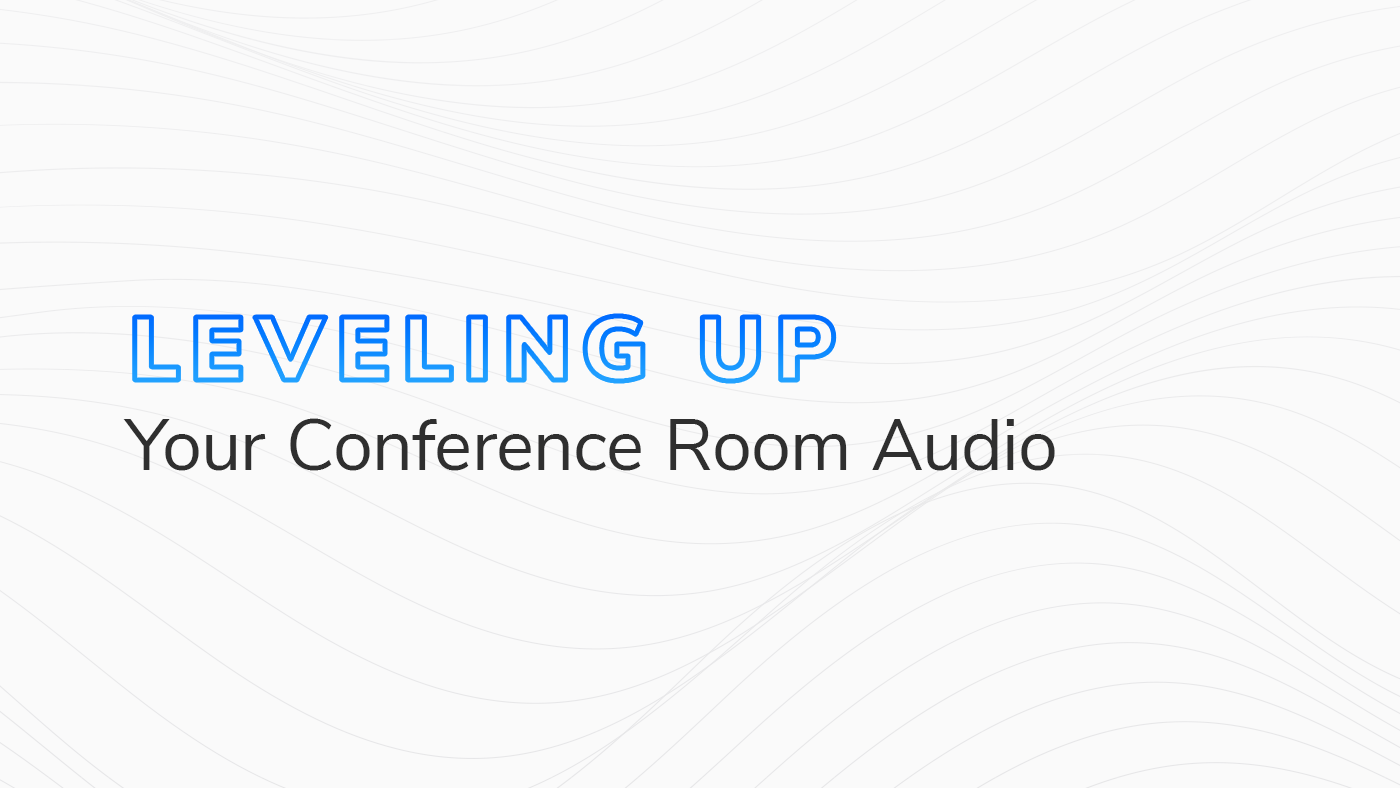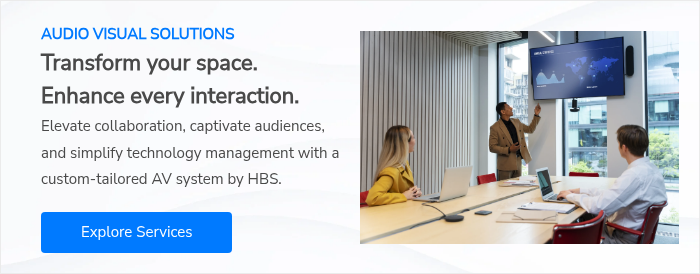The Future of Conference Room Audio: Innovations and Best Practices
- Written by: Ryan Mosher

Good, quality conference room audio isn't a luxury; it's a necessity. Think about it: how often are meetings derailed by muffled sounds, dropped calls, and annoying echoes? These issues lead to frustration, wasted time, a less productive work environment, and, if a client is involved, a poor look for your business.
In this article, we'll explore the impact of poor audio on communication and collaboration. We'll also discuss the latest conference room audio technology innovations and best practices to ensure your meetings run smoothly and efficiently.
By the end, you'll be equipped with the knowledge to transform your conference calls from frustrating experiences into productive and engaging sessions.

The Importance of Quality Audio
Conference room audio quality is about more than avoiding annoyance. Here are some of the tangible impacts of audio on communication, collaboration, and the overall meeting experience:
Impact on Communication:
- Improved Comprehension: Crystal-clear audio ensures accurate message delivery and reduces misunderstandings. This minimizes the need for clarification requests and wasted meeting time.
- Enhanced Collaboration: High-fidelity audio fosters active participation and real-time engagement, leading to more productive brainstorming sessions and collaborative decision-making.
- Elevated User Experience: A professional audio experience avoids frustration and fatigue for participants, fostering a more positive and productive meeting environment.
And now, here are some of the challenges that poor audio in conferencing presents:
Challenges of Poor Audio:
- Acoustic Issues: Echo, reverberation, and background noise can significantly degrade speech and create a confusing listening experience.
- Microphone Limitations: Improper microphone placement or inadequate pickup range can exclude remote or quiet participants from the conversation.
- Bandwidth Constraints: Insufficient network bandwidth can lead to audio dropouts, choppiness, and delays, hindering the flow of communication.
The ROI of Crystal Clear Audio: Why Improving Your Conference Rooms Makes Dollars (and Sense)
Top-notch conference room audio is about more than just avoiding grainy calls and complaints. It's an investment with a healthy return. Here's how improved audio translates to noticeable business benefits:
- Boosted Productivity: Clear communication is the cornerstone of effective meetings. When everyone can hear and be heard clearly, meetings become more focused and productive. Less time is wasted on misunderstandings and clarifications, allowing teams to achieve more in each session.
- Enhanced Collaboration: High-quality audio fosters a more engaged and interactive meeting environment. Participants are more likely to actively contribute and share ideas when they can hear everyone clearly. This can lead to better brainstorming sessions, more creative problem-solving, and improved decision-making.
- Employee Satisfaction: Grappling with muffled audio or dropped calls can be frustrating and lead to employee dissatisfaction. Upgrading your conference room audio system shows your commitment to creating a positive and productive work environment.
- Improved Client Perception: Flawless audio during conferences with clients or partners projects a professional and polished image. This can enhance client perception of your company and help build stronger business relationships.
Investing in conference room audio solutions isn't just about better sound quality; it's about creating a more efficient, collaborative, and successful work environment.
Level Up Your Conferencing: New Innovations in Audio
Gone are the days of fiddling with knobs and wrestling with tangled wires. Here's how cutting-edge technologies are redefining conference room audio:
- Beamforming Microphones: Imagine a microphone that acts like a spotlight for sound. These clever mics focus on the speaker's voice, filtering out distracting background noise, even in large conference rooms with participants scattered around the table. Crystal clear audio, guaranteed.
- AI Audio Powerhouse: Artificial intelligence is the new superhero of conference calls. AI tech enhances noise cancellation in real time, constantly optimizing sound quality. Think of it as a magic equalizer that automatically adjusts for the smoothest possible conversation. But AI doesn't stop there. Imagine using your voice (like with Siri or Alexa) to control the AV equipment, adjust microphone levels, or even manage shared screens. Voice-activated command technology is the future, and it's here now.
- Wireless Freedom: Say goodbye to cable chaos! Wireless audio systems offer ultimate flexibility, eliminating the need for bulky wires and tangled messes. This lets you easily reconfigure your conference room layout on the fly, perfect for dynamic environments where space and participant numbers constantly change.
- Seamless Video Conferencing Integration: The new era of conference audio plays nicely with others. Advanced systems seamlessly integrate with popular video conferencing platforms, ensuring consistent and high-quality audio for in-person and remote participants—no more dropped calls or choppy audio disrupting your meetings.

Taming the Acoustics: Best Practices for Crystal-Clear Audio
Even the fanciest equipment can't overcome a room with bad acoustics. Here's how to turn your large or small conference room into an audio oasis:
- Conquer the Echo Chamber: Bare walls and glass surfaces are notorious for creating reverberation—that annoying echo that makes it hard to follow a conversation. The solution? Softer materials. Think plush carpets, thick curtains, and upholstered furniture. These act like sound sponges, absorbing echoes and keeping your audio crisp. For extra absorption power, consider installing acoustic ceiling tiles, wall panels, or even hanging baffles from the ceiling.
- Microphone Magic: Placement is critical. In large conference rooms, ceiling-mounted microphones with wide pickup ranges ensure everyone's voice is heard. In smaller rooms, desk-mounted microphones might be better suited, but make sure they're positioned to capture all participants without causing feedback. Remember, noise-canceling technology is your friend, especially in busy environments.
- Preventative Maintenance: Your conference room audio system isn't a set-and-forget situation. Regular checkups are essential. Schedule routine inspections to identify potential problems before they disrupt a crucial meeting. Software updates and occasional hardware tweaks can keep your audio system running smoothly.
- Empowering Your Users: A little knowledge goes a long way. User training on basic audio equipment operation can prevent many headaches. Clear instructions and quick reference guides empower users to adjust microphone levels, mute themselves, and troubleshoot minor issues independently. This keeps meetings on track and minimizes IT support calls.
Conclusion: Invest in Audio, Invest in Success
Upgrading your conference room audio system isn't just about better sound quality; it's an investment in the future of your business. Crystal-clear audio fosters better communication, boosts collaboration, and improves employee satisfaction. On top of that, it can reduce travel costs and leave a positive impression on clients and partners.
Ready to transform your conference experience? HBS offers a wide range of conference room audio solutions to fit your specific needs and budget. Our team of experts can help you design, install, and maintain a system that ensures flawless audio every time. Contact us today to begin.








